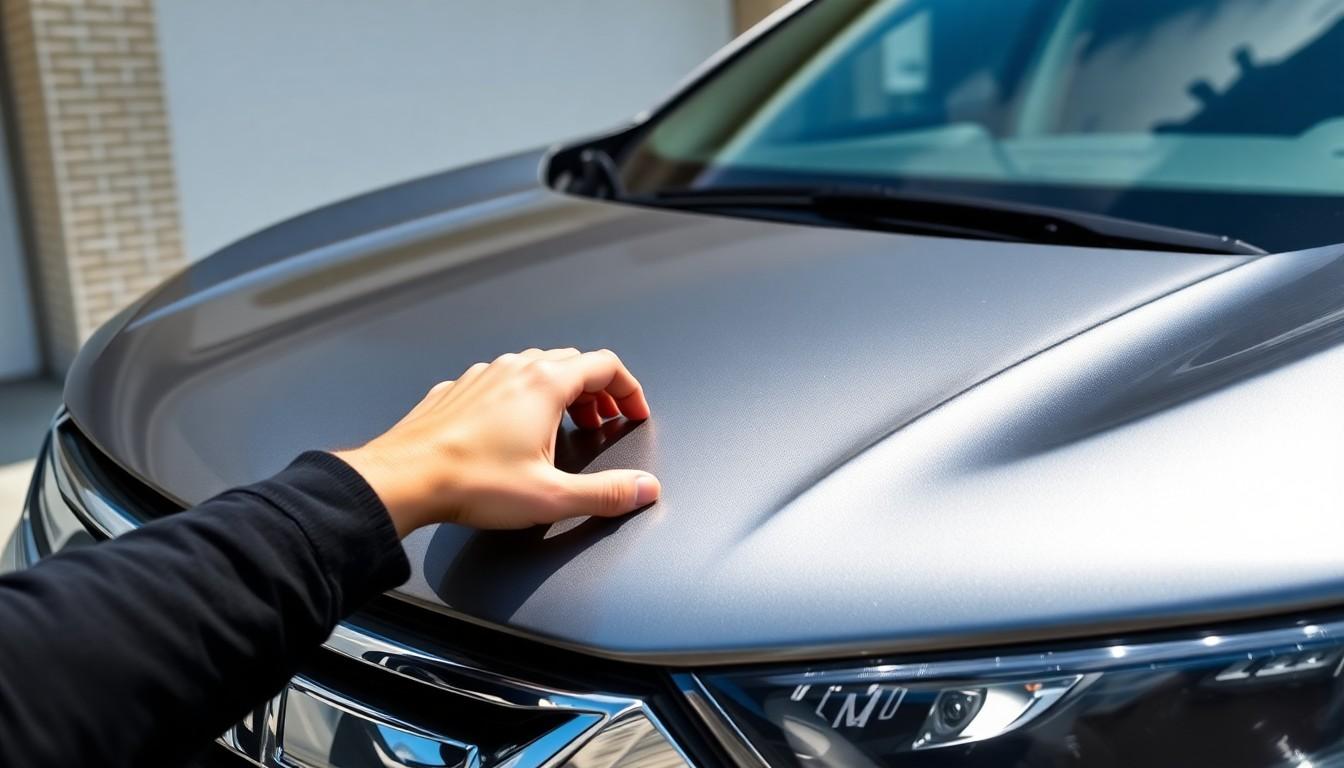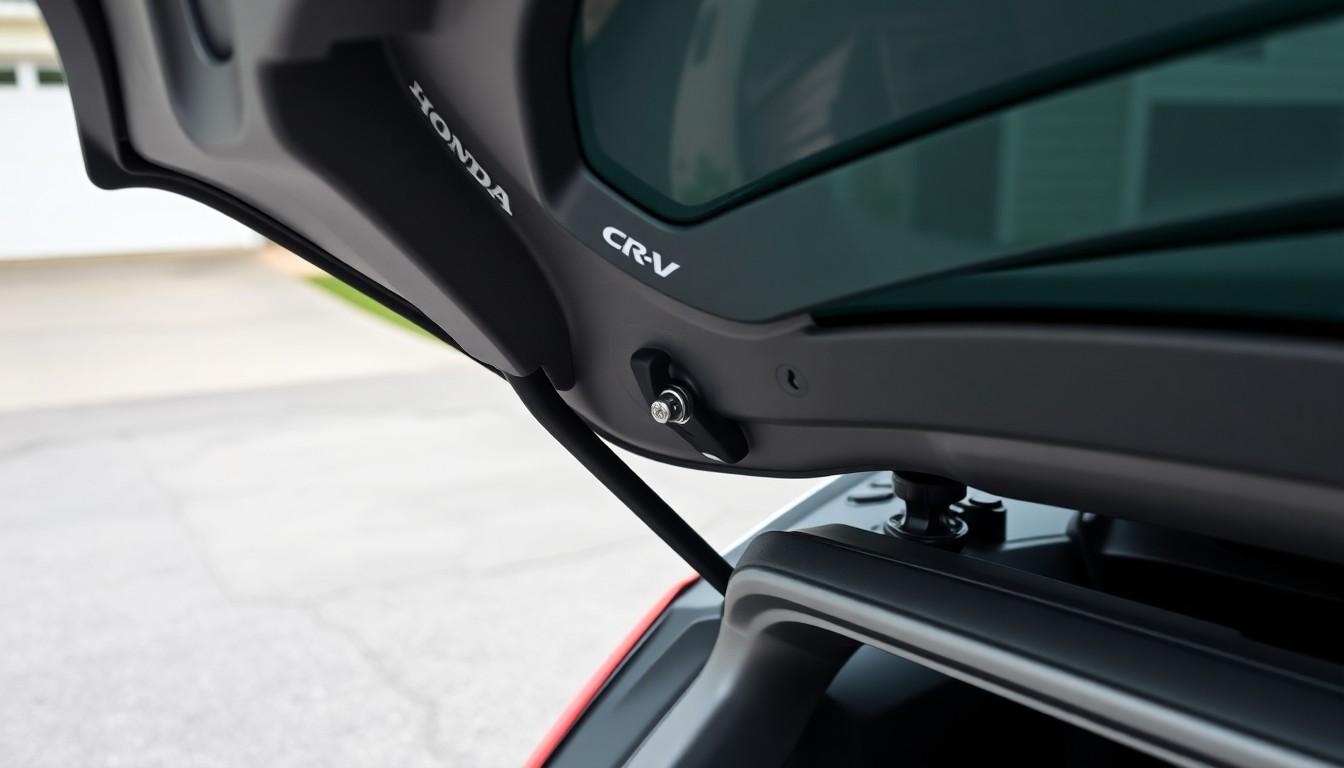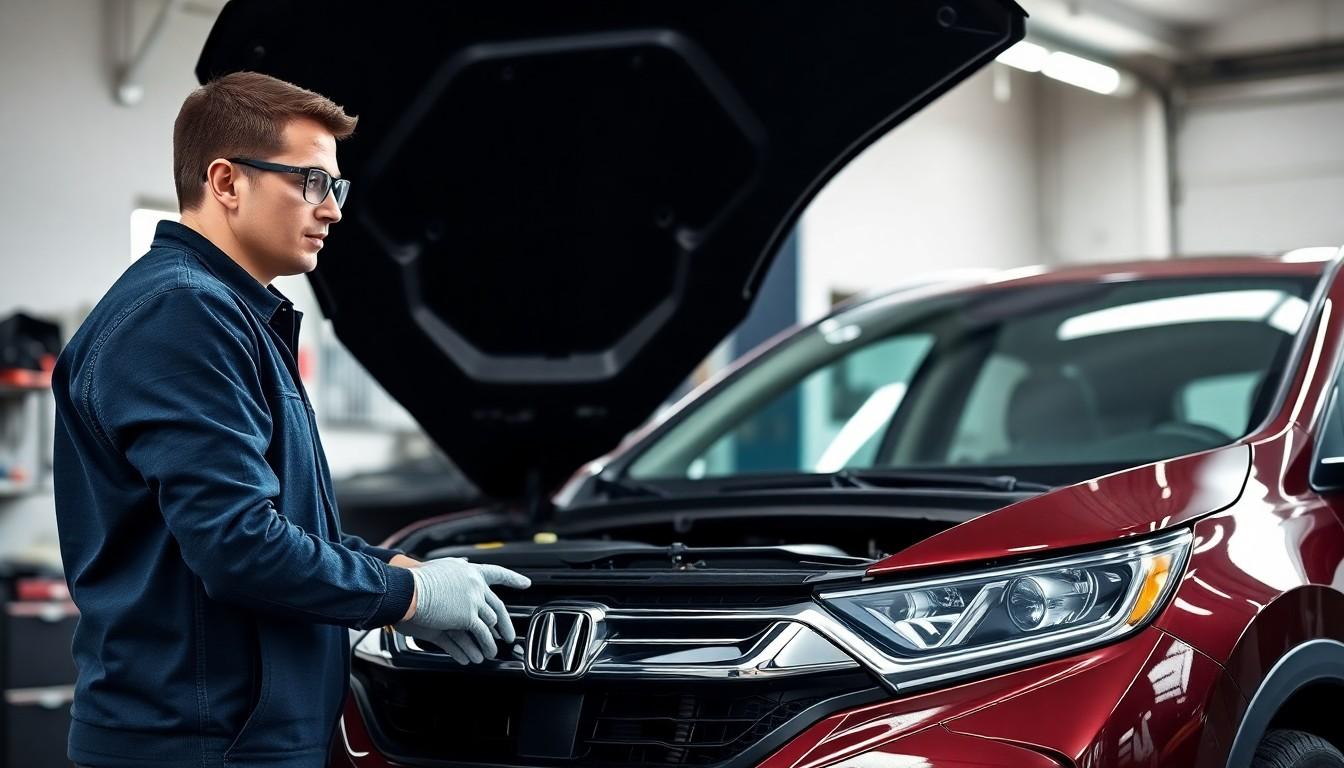Need to pop the hood of your Honda CR-V but aren’t quite sure how? Don’t worry—you’re not alone. Many CR-V owners find themselves searching for this basic but essential information, especially when it’s time for routine maintenance or troubleshooting engine issues.
We’ve created this straightforward guide to help you quickly and easily access your Honda CR-V’s engine compartment. Whether you’re checking fluid levels, replacing the battery, or just getting familiar with what’s under the hood, knowing how to properly open your CR-V’s hood is the crucial first step to maintaining your vehicle’s performance and longevity.
Understanding Your Honda CR-V Hood Release System
The Honda CR-V incorporates a two-stage hood release system designed for safety and convenience. This dual-action mechanism prevents accidental hood openings while driving at high speeds on highways or during normal city commutes.
Every CR-V model features an interior hood release lever located below the dashboard on the driver’s side. This primary release disengages the main hood latch but doesn’t fully release the hood. After pulling this interior lever, a secondary safety latch requires manual disengagement from the front of the vehicle.
Honda engineers positioned the secondary release in a slightly different location depending on your CR-V’s generation. Most models have this safety latch centered under the hood’s leading edge or slightly offset toward the driver’s side. The secondary latch typically requires pushing sideways or upward while simultaneously lifting the hood.
This thoughtful design ensures both safety and security for your vehicle. The two-step process eliminates concerns about hood fly-ups caused by accidental bumps against the interior release lever. Understanding this mechanism makes routine maintenance tasks like checking your oil level or inspecting your battery connections much more straightforward.
Step-by-Step Guide to Opening Your Honda CR-V Hood

Opening your Honda CR-V’s hood involves a simple two-stage process that varies slightly depending on your vehicle’s model year. Let’s break down each step to ensure you can access your engine compartment safely and easily.
Locating the Interior Hood Release Lever
The interior hood release lever location is consistent across most Honda CR-V models, with minor variations by year. In the 2024 Honda CR-V, you’ll find this lever under the driver’s side lower corner of the dashboard. Owners of the 2016 model should look under the left-hand inner kick panel where it’s typically marked with a small icon showing a vehicle with an open hood. For the 2015 CR-V, the release lever sits in the driver’s side footwell area, positioned below and to the right of the fuel door release lever. Pulling this lever is your first step and causes the hood to pop up slightly.
Operating the Secondary Safety Latch
After pulling the interior lever, your hood will only release partially as a safety feature. For the 2024 CR-V, you’ll need to push the hood latch lever (located under the front edge of the hood) toward the center, then lift the hood upward. In the 2016 model, stand at the front center of your vehicle, reach between the hood and grille, feel for the latch underneath, and push it with your fingers to release the hood completely. The 2015 CR-V requires you to insert your hand between the hood and the top of the grille, locate the secondary release lever, and pull it up and toward the right to fully unlatch the hood.
Proper Hood Support Rod Usage
Honda CR-Vs feature different support systems depending on the model year. The 2024 CR-V comes equipped with hydraulic supports that automatically lift and hold the hood in place once you’ve unlatched it. When closing this model’s hood, lower it to approximately 12 inches (30 cm) above closing position, then press down firmly with your hands to secure it. Earlier models like the 2016 and 2015 CR-Vs likely require manual support using a prop rod, though exact details aren’t mentioned in the available information. Always park on level ground with the parking brake engaged before opening your hood, and avoid opening it when the wiper arms are raised to prevent damage to both the hood and wipers.
Common Honda CR-V Hood Opening Problems

Honda CR-V owners occasionally encounter issues when trying to open their vehicle’s hood. These problems typically fall into two main categories: stuck latches and broken cables. Let’s explore both issues and their answers.
Stuck or Frozen Hood Latch Issues
A stuck or frozen hood latch prevents the hood from opening even when you pull the interior release lever. Access to the latch mechanism can be gained from underneath the car when facing this problem. Start by removing the plastic bottom cover or splash shield to reach the area behind the frame bar and in front of the oil pan. Once exposed, use a long, skinny flathead screwdriver or your hand to reach the latch mechanism. The key to releasing a stuck latch is pushing it toward the passenger side, which should disengage the hood and allow it to open. Raising the front end of your CR-V on ramps can significantly improve access to this area and make the manual release process easier.
Broken Cable Troubleshooting
The hood release cable might break or become dislodged, making the interior release lever ineffective. Checking for cable movement when pulling the interior release helps diagnose this issue. If no movement occurs, you’ll need to access the mechanism from underneath the vehicle. Remove the bottom splash shield and locate the cable near the transmission filter between the support frame and radiator support. Manually releasing the hood involves sliding your hand or a long screwdriver behind the frame bar and pushing the latch toward the passenger side. Take care not to damage the spring or other components during this process, as a mangled spring may necessitate replacing the entire latch assembly. Professional mechanical assistance is recommended if you’re uncomfortable performing these steps to avoid causing further damage to your Honda CR-V’s hood release system.
Maintenance Tips for Your Honda CR-V Hood Mechanism

Proper maintenance of your Honda CR-V’s hood mechanism ensures smooth operation and prevents potential issues. Regular attention to this often-overlooked component extends its lifespan and maintains safety during engine compartment access.
Regular Lubrication Schedule
The hood latch mechanism requires periodic cleaning and lubrication to maintain optimal performance. Apply lubricant when the latch moves stiffly or if you notice the hood can be opened without lifting the lever. Silicone-based lubricants work best for the moving parts of the hood mechanism, creating a protective barrier against moisture and corrosion. Applying lubricant every six months preserves smooth operation, especially in areas with extreme weather conditions that accelerate wear on mechanical components.
When to Replace Hood Components
Hood components showing exact signs of wear or damage need replacement to maintain safety and functionality. Replace the hood latch mechanism if cleaning and lubrication don’t resolve stiffness issues or if structural damage is visible. Hydraulic supports require replacement when they fail to hold the hood up securely, forcing you to manually support it during engine compartment access. Components exhibiting important rust, corrosion, or physical damage compromise the hood’s integrity and operation, necessitating immediate replacement. Regular inspection of these parts during routine maintenance helps identify potential failures before they become safety hazards.
Safety Precautions When Working Under Your CR-V Hood

Working under the hood of your Honda CR-V requires careful attention to safety protocols that protect both you and your vehicle. Following these essential precautions helps prevent injuries and potential hazards during maintenance and repairs.
General Safety Measures
Always park your CR-V on level ground with the parking brake firmly engaged before attempting any under-hood work. Turn off the engine completely and remove the key from the ignition to prevent accidental starts. Position your vehicle in a well-ventilated area, especially if you need to run the engine during diagnostics, as exhaust contains carbon monoxide that can be lethal in enclosed spaces.
Fire Prevention Strategies
Keep all flammable materials like rags, paper towels, and cleaning cloths away from the engine compartment. Heat from the engine and exhaust system can easily ignite these items, creating a dangerous fire hazard. Maintain a clean engine bay by using commercial degreasers or exact parts cleaners rather than gasoline, which poses important fire risks.
Essential Protective Equipment
Wear appropriate eye protection when working with batteries or using compressed air for cleaning components. Protective gloves and clothing shield your skin from harmful chemicals, hot surfaces, and sharp edges commonly found under the hood. These simple protective measures significantly reduce the risk of injuries during maintenance tasks.
Hot Components and Moving Parts
Allow your CR-V’s engine and exhaust system to cool completely before touching any components. Engine parts can reach extremely high temperatures during operation and retain heat long after shutdown. Stay clear of moving components like belts, pulleys, and fans, especially if the engine must be running during your inspection or repair process.
Exact CR-V Considerations
Honda CR-V models equipped with Auto Idle Stop technology require special attention. Never open the hood while this function is activated as it could result in unexpected engine restart. Keep cigarettes, sparks, and open flames away from the battery and fuel system components to prevent fire or explosion risks. Always ensure your hands and limbs are positioned safely away from pinch points before closing the hood.
By incorporating these safety practices into your maintenance routine, you’ll create a safer working environment when accessing components under your Honda CR-V’s hood. Regular attention to these precautions protects both you and your vehicle during necessary service work.
Conclusion
Opening your Honda CR-V’s hood is a fundamental skill that empowers you to maintain your vehicle properly. We’ve walked through the two-stage hood release system across different model years and provided answers for common problems you might encounter.
Remember that regular maintenance of the hood mechanism itself is just as important as the engine components it protects. By lubricating the latches semi-annually and promptly addressing any issues that arise you’ll ensure smooth access when you need it most.
Always prioritize safety when working under the hood by parking on level ground wearing appropriate protection and keeping the engine area clean. With these practices in mind you’ll be well-equipped to handle basic maintenance and keep your CR-V running at its best for years to come.
Frequently Asked Questions
How do I open the hood of my Honda CR-V?
To open the hood of your Honda CR-V, first locate the interior hood release lever below the dashboard on the driver’s side and pull it. This will partially release the hood. Then, go to the front of the vehicle and find the secondary safety latch (usually near the center of the hood). Push or slide this latch to the side while lifting the hood. Once open, secure it with the support rod or rely on the hydraulic supports if your model has them.
Where is the hood release lever located in a Honda CR-V?
The hood release lever in a Honda CR-V is located below the dashboard on the driver’s side, typically to the left of the footwell. In most models, it’s marked with a small hood icon. The exact position may vary slightly between different model years, but it’s always within easy reach of the driver while seated.
Why won’t my Honda CR-V hood open?
If your Honda CR-V hood won’t open, there could be several causes: a stuck latch mechanism, broken release cable, misaligned hood, or corrosion in the latch components. Try pulling the interior release lever multiple times while gently pushing down on the hood. If that doesn’t work, try spraying penetrating oil on the latch or seeking professional help if these solutions fail.
How often should I lubricate my Honda CR-V’s hood latch?
You should lubricate your Honda CR-V’s hood latch approximately every six months or more frequently if you live in areas with harsh weather conditions. Use a silicone-based lubricant which resists moisture and prevents corrosion. Apply it to both the primary interior latch mechanism and the secondary safety latch at the front of the vehicle.
What safety precautions should I take when working under the hood?
When working under the hood of your Honda CR-V, always park on level ground and ensure the engine is off. Let the engine cool before touching components. Ensure proper ventilation to prevent carbon monoxide buildup. Keep flammable materials away from the engine compartment. Wear protective gloves and eyewear. For models with Auto Idle Stop, ensure this feature is deactivated before opening the hood.
How do I know if my Honda CR-V’s hood support needs replacement?
Your Honda CR-V’s hood support needs replacement if the hood doesn’t stay up on its own, slowly closes while you’re working, or shows visible signs of damage like leaking hydraulic fluid, rust, or bends. For models with hydraulic supports, both sides should be replaced at the same time, even if only one is failing, to ensure balanced support and safety.
What maintenance tasks require opening the hood of my CR-V?
Opening the hood of your CR-V is necessary for several important maintenance tasks: checking and topping off engine oil, coolant, brake fluid, power steering fluid, and windshield washer fluid; inspecting and replacing the air filter; examining belts and hoses for wear; checking the battery condition; replacing wiper blades; and inspecting for any visible leaks or damage to engine components.
Can I open the hood of my Honda CR-V when the engine is running?
While technically possible, it’s not recommended to open the hood of your Honda CR-V when the engine is running. This creates safety hazards including moving parts that could cause injury, hot components that could burn you, and the risk of accidentally dropping items into the engine. If diagnostic checks require the engine to run, exercise extreme caution and seek professional help when possible.

